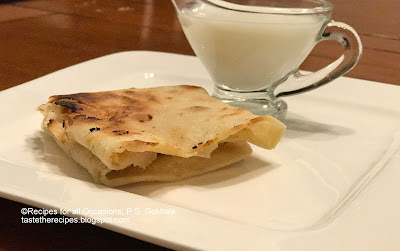This is a halwa I had eaten eons ago as a kid when I visited Mumbai. We didn't indulge in this sweet a lot because the ones that are store bought are made using hydrogenated oil and were thought to be too unhealthy. I was searching for this recipe because a sweet that a friend shared reminded me of it. I came across many recipes but they all used semolina/rava as the main ingredient. The original version is made using corn starch. I wanted to make it as close to the store bought version but use clarified butter or ghee instead of hydrogenated oil. I liked the video demonstration of the technique on Bhavna's kitchen channel. It is a fairly straightforward recipe and the only thing that makes it challenging is the continuous stirring that it essential to getting the right texture.
Ingredients
Ingredients
1/4 cup corn starch
1/4 cup plus 2 tsp ghee (you can increase the ghee amount to 1/2 cup if you want)1 cup water or milk
1 cup sugar
1 tsp rose water (optional)
1/2 tsp cardamom powder
15-20 strands of saffron crushed
1 tbsp finely sliced almonds and pistachio (optional)
Method
Make sure to prepare the surface on which you will roll the halwa ready. You can use a silicone mat and a sheet of parchment or a couple sheets of parchment (approx 2 ft in length). If using aluminum foil or the back surface of a baking sheet, make sure to grease it with ghee before you start the cooking process. I do not use plastic sheets as the mixture is hot and I do not want any plastic leaching into the halwa.
In an open flat saucepan (helps with faster evaporation) mix together the corn starch,1/4 cup ghee, water/milk and sugar. Stir it and keep it aside for 20-30 mins and let the ingredients soak. Then stir the mixture well to dissolve most of the sugar and ensure that there are no lumps of cornstarch. Then put it on low medium heat and stir this mixture continuously. In the beginning while it is still very fluid, you do not need to stir it constantly but as soon as the mixture starts to heat up, keep stirring constantly to avoid lumps. This is a little laborious but well worth it in the end. Keep the heat at medium low and keep stirring and press down any lumps that start to form( about 20-30 mins) till it comes together like a dough. Now turn off the heat and add the remaining 2 tsps of ghee and knead it with your spatula and bring the mixture together and then mix in the rose water, if using.
Now it is important to work fast. Pour this dough onto a silpat/parchment/prepared aluminum foil. Place another parchment paper on top of the dough sandwiching the dough between the two. Then roll out the dough as thin as possible. Peel the paper intermittently and check how thin it is. It should be transparent. That's when you know it is at the right thinness. Then sprinkle the cardamom, saffron and nuts over the rolled dough, place the parchment paper again and lightly roll over the sprinkled spice and nut mixture embedding it into the halwa. Now peel the paper and let it dry.
When it is semi dry, cut the rolled sheet into squares. It can take from a couple of hours to a few hours or overnight for the halwa to dry and get the perfect texture, depending on the weather, humidity, and rolled dough thickness. Separate into squares when completely dry. Alternate wax paper or parchment paper sheets cut to the same dimensions as the halwa, between each halwa slice. Your halwa is ready to serve. Store in the fridge.
If you use rose water when the heat is still on, the fragrance will disintegrate and you may not get that rose fragrance. You can also make colorful halwa by adding a few drops of color to the mixture when you soak the ingredients together.









































